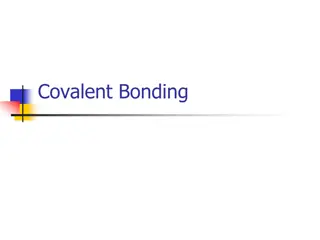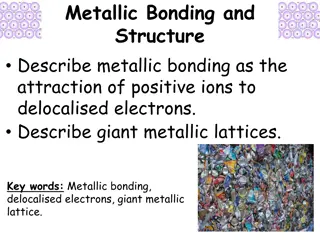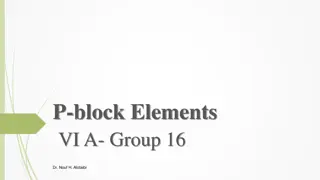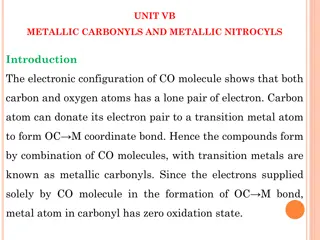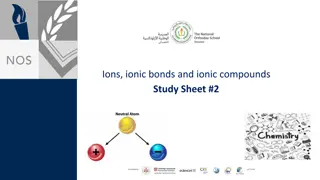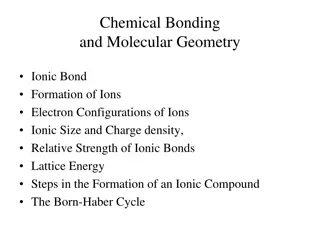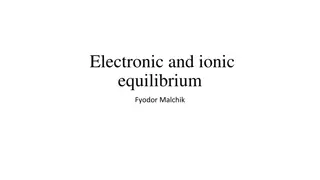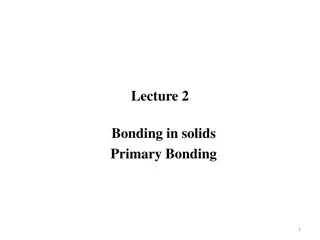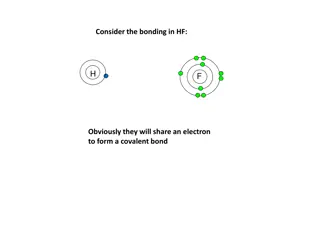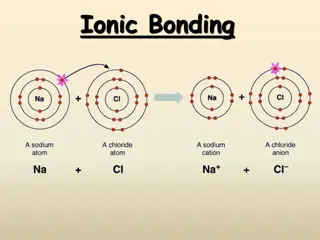Understanding Ionic and Metallic Bonding in Chemistry
Explore the concepts of ionic and metallic bonding in chemistry through discussions on valence electrons, electron dot structures, the octet rule, cations, anions, and more. Dive into the world of ions and electron configurations to understand how atoms achieve stability through the gain or loss of electrons.
Download Presentation

Please find below an Image/Link to download the presentation.
The content on the website is provided AS IS for your information and personal use only. It may not be sold, licensed, or shared on other websites without obtaining consent from the author. Download presentation by click this link. If you encounter any issues during the download, it is possible that the publisher has removed the file from their server.
E N D
Presentation Transcript
Chapter 7 Ionic and Metallic Bonding Jennie L. Borders
Section 7.1 - Ions Valence electrons are the electrons in the highest occupied energy level. Valence electrons are the only electrons involved in chemical bonding. Elements in the same group have the same number of valence electrons.
Electron Dot Structures Electron dot structures are diagrams that show the symbol of the element surrounded by the valence electrons as dots.
Practice Problems Write the electron dot structure for the following elements: P Ar Mg He
Octet Rule The octet rule states that atoms tend to achieve a stable configuration when they have 8 valence electrons. An octet of electrons consists of full s and p sublevels. Metals tend to lose electrons to achieve noble-gas configuration. Nonmetals tend to gain electrons to achieve noble-gas configuration. Transition metals generally do no form ions that have a noble-gas configuration.
Cations A cation ion is a positive ion that has lost electrons. A loss of electrons from an atom is always an endothermic process (requires or absorbs energy). When writing the electron configuration for a cation, write the electron configuration for the atom and then subtract the electrons from the highest energy level. When you name a cation, the name of the element does not change. Ex: Ca+2= calcium ion
Sample Problem Write the electron configuration and name for the following: Sr2+ Fe+3
Practice Problems Write the electron configurations and the name for the following: Ga+3 Na+
Anions Anions are negatively charged ions that have gained electrons. The gain of electrons is an exothermic process (loss or release of energy) When writing the electron configuration for anions, write the electron configuration for the atom and then add the correct number of electrons. When naming an anion, you change the ending of the element to ide. Ex: Cl-= chloride ion
Sample Problems Write the electron configuration and name for the following: P-3 F-
Practice Problems Write the electron configuration and name for the following: Br- S-2
Sample Exercise Give the chemical symbol, including mass number, for each of the following ions: a. the ion with 22 protons, 26 neutrons, and 19 electrons b. the ion of sulfur that has 16 neutrons and 18 electrons
Practice Exercise How many protons, neutrons, and electrons does the 79Se2-ion possess?
Sample Exercise Predict the change expected for the most stable ion of barium and for the most stable ion of oxygen.
Practice Exercise Predict the charge expected for the most stable ion of aluminum and of fluorine.
Section 7.1 Assessment 1. How can you determine the number of valence electrons in an atom of a representative element? 2. Atoms of which elements tend to gain electrons? Atoms of which elements tend to lose electrons? 3. How do cations form? 4. How do anions form? 5. How many valence electrons are in each atom? a. Potassium b. Carbon c. Magnesium d. Oxygen 6. Draw the electron dot structure for each element in question 5.
Section 7.1 Assessment 7. How many electrons will each element gain or lose in forming an ion? a. calcium b. fluorine c. aluminum d. oxygen 8. Write the name and symbol of the ion formed when a. a potassium atom loses one electron. b. a zinc atom loses two electrons. c. a fluorine atom gains one electron. 9. Write the electron configuration of Cd+2.
Section 7.2 Ionic Bonds and Ionic Compounds Compounds composed of cations and anions are called ionic compounds. Ionic compounds are usually composed of a metal and a nonmetal. In contrast, molecular compounds are generally composed of nonmetals only. Although they are composed of ions, ionic compounds are electrically neutral. The electrostatic forces that hold ions together are called ionic bonds.
Sample Exercise Which of the following compounds would you expect to be ionic: N2O, Na2O, CaCl2, SF4?
Practice Exercise Which of the following compounds are molecular: CBr4, FeS, P4O6, PbF2?
Formulas A chemical formula shows the kinds and numbers of atoms in the smallest representative unit of a substance. A formula unit is the lowest whole-number ratio of ions in an ionic compound.
Balancing Charges When you balance charges to write the formula for an ionic compound, you must make the + charge and charge equal by adding subscripts. The subscripts must be in the lowest ratio to be correct.
Sample Problems Write the formula for the compound formed between the following elements. Potassium and oxygen Magnesium and nitrogen
Practice Problems Write the formula for the compound when the following elements combine. Potassium and iodine Aluminum and oxygen Calcium and chlorine Barium and sulfur
Polyatomic Ions Polyatomic ions are a group of atoms with an overall charge. When a compound contains a polyatomic ion, the ions are held together by ionic bonds, but the polyatomic ions is composed of covalent bonds. When balancing charges for polyatomic ions, you follow the same rule of cancelling the + and charge. However, if you need to add a subscript to a polyatomic ion, then you have to put the polyatomic ion in parentheses. Ex: Ca(NO3)2
Sample Problems Write the formula for the compound when the following ions combine: Sodium and phosphate Ammonium nitride Aluminum carbonate
Practice Problems Write the formula for the compound when the following ions combine: Barium nitrate Lithium phosphate Strontium sulfite
Properties of Ionic Compounds Properties of ionic compounds include the following: Crystalline solids High melting points Conduct electricity when molten or aqueous Made of metals and nonmetals Made of cations and anions Made of ionic bonds
Crystals A crystal is a substance with a 3-D repeating arrangement of particles called the crystal lattice. The coordination number of an ion is the number ions of opposite charge that surround the ion in a crystal.
Ionic Bonding An ionic bond involves the transfer or electrons between a cation and an anion. The loss of electrons is always an endothermic process. The gaining of electrons is generally an exothermic process. When ions come together, energy is released, so ionic compounds are stable.
Lattice Energy Lattice energy is the energy required to completely separate a mole of a solid ionic compound into its gaseous ions. All are large positive values, indicating that the ions are strongly attracted to one another in these solids.
Lattice Energy Coulomb s law is as follows: Eel= kQ1Q2 d Thus, for a given arrangement of ions, the lattice energy increases as the charges on the ions increase and as their radii decrease.
Sample Exercise Arrange the following ionic compounds in order of increasing lattice energy: NaF, CsI, and CaO.
Practice Exercise Which substance would you expect to have the greatest lattice energy, MgF2, CaF2, or ZrO2?
Section 7.2 Assessment 1. How can you describe the electrical charge of an ionic compound? 2. What properties characterize ionic compounds? 3. Write the correct chemical formula for the compounds formed by each pair of ions. a. K+, S-2 b. Ca+2, O-2 c. Na+, O-2 d. Al+3, N-3
Section 7.2 Assessment 4. Write formulas for each compound. a. barium chloride b. Magnesium oxide c. Lithium oxide d. Calcium fluoride 5. Which pairs of elements are likely to form ionic compounds? a. Cl, Br b. Li, Cl c. K, He d. I, Na
Section 7.3 Bonding in Metals The valence electrons of metal atoms can be modeled as a sea of electrons. Metallic bonds consist of the attraction of the free-floating valence electrons for the positively charged metal ions. Metals are good conductors and malleable because of their mobile electrons.
Metals Metals are the most simple crystals because they contain one type of element.
Alloys An alloy is a mixture with metallic properties. A substitutional alloy is made when atoms of one metal replace atoms of another metal. An interstitial alloy is made when smaller metal atoms are inserted in between larger metal atoms.
Section 7.3 Assessment 1. How do chemists model the valence electrons in metal atoms? 2. How can you describe the arrangement of atoms in metals? 3. Why are alloys more useful than pure metals? 4. Describe what is meant by ductile and malleable.
Section 9.1 Naming with Regular Metals The system used in naming substances is called chemical nomenclature. A monatomic ion is a single atom with a charge. Ex: Na+or O-2 When naming a cation, the name of the element does not change. Ex: K+= potassium When naming an anion, the ending of the element changes to ide. Ex: O-2= oxide
Polyatomic Ions A polyatomic ion is a group of atoms with an overall charge. Ex: SO4-2 Most polyatomic ions end in ate or ite. The ending does not change when naming a compound (unless it is an acid which we will talk about later). The ate suffix indicates that the polyatomic ion contains one more oxygen than the polyatomic ion with the ite suffix. (Ex: sulfate = SO4- 2, sulfite = SO3-2)
Sample Problem Based on the formula of the sulfate ion, predict the formula for the following. Remember that sulfur and selenium are in the same group. a. the selenate ion b. the selenite ion
Practice Problem The formula for the bromate ion is analogous to that for the chlorate ion. Write the formula for the hypobromite and perbromate ions.
Naming with Regular Metals The regular metals are located in groups 1 and 2 (except for H). Aluminum is also a regular metal. When naming a compound that starts with a regular metal, you name the metal (cation) and add ide to the nonmetal (anion). Ex: NaCl = sodium chloride If the anion is a polyatomic ion, then you do not change the ending. Ex: CaCO3= calcium carbonate
Sample Problems Name the following compounds: Na2O AlBr3 Li2SO4
Practice Problems Name the following compounds: LiNO3 Ca2(PO4)3 (NH4)2O
Writing the Formula with Regular Metals When writing the formula of a compound that starts with a regular metal, you must BALANCE THE CHARGES. Ex: aluminum bromide AlBr balance charges Al+3Br- AlBr3
Sample Problems Write the formula for the following compounds: Aluminum chloride Calcium acetate Lithium fluoride






